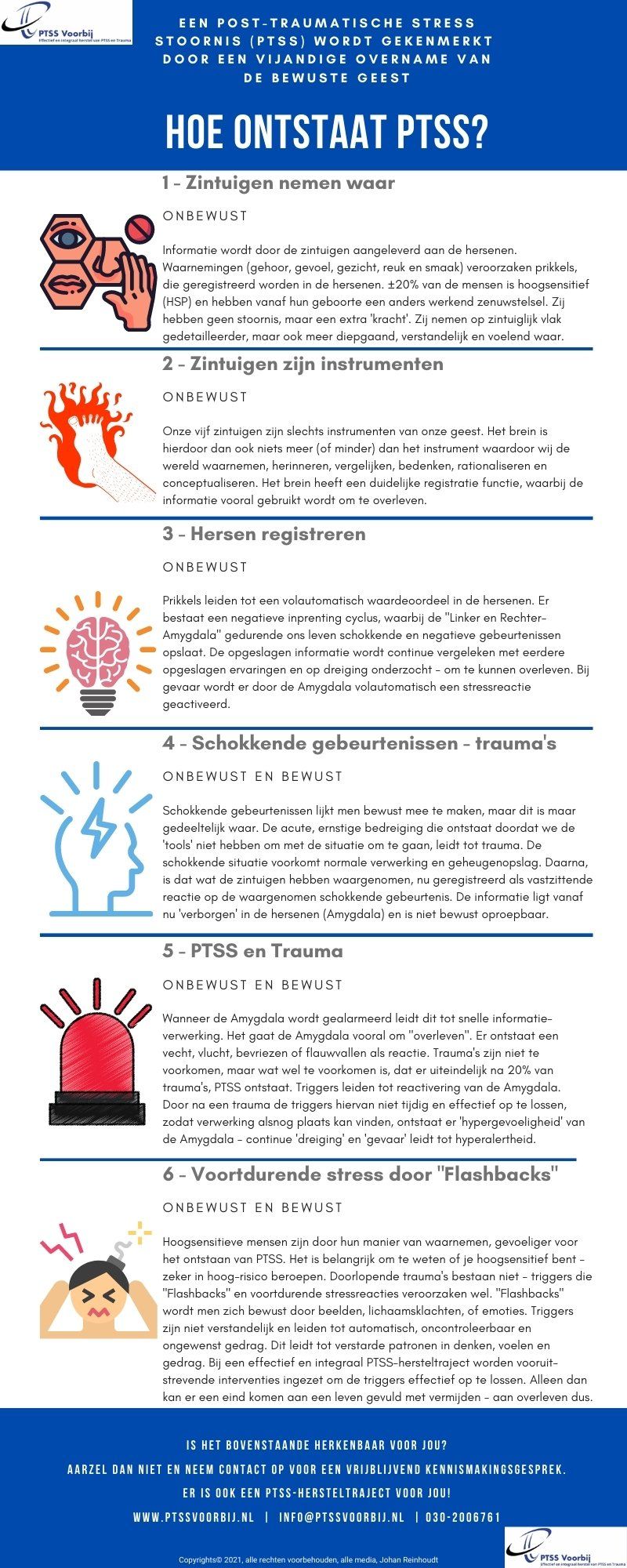What is a Post Traumatic Stress Disorder?
Introduction
-
Post Traumatic Stress Disorder
A Post-Traumatic Stress Disorder is mainly referred to and abbreviated as "PTSD". In the Dutch translation of the “Handbook for the Classification of Mental Disorders (DSM-5)”, translated from the American “Diagnostic and Statistical Manual of Mental Disorders-DSM-5®”, PTSD falls under the group of “trauma and stressor-related complaints”.
PTSD is described as a mental illness in the literature, a disease state that arises when an unexpected, stressful, traumatic event confronts someone - a situation that cannot be adequately processed (biologically) by the person at that moment. The situation causes a potential threat to 'physical inviolability', the physical integrity of the person. When a person is exposed to a traumatic experience that cannot be processed, various and eventually increasingly severe symptoms often arise.
A Post-Traumatic Stress Disorder (PTSD) is only spoken of if the complaints persist for more than a month. If the symptoms persist for less than a month, this is referred to as an Acute Stress Disorder (ASD).
Below is shown how the development of PTSD leads to conscious perception, undesirable behavior, and re-experience. People must clearly distinguish between PTSD and normal coping with a shocking event, the emotional consequences of which often disappear within a few weeks.
The 'steps' in the development of PTSD:
1. Unconscious sensory registration – perception through the five (5) senses (hearing, touch, sight, smell, and taste).
2. Unconscious automatic emotional perception acquires an impartial value judgment in the limbic system in the brain (mainly through the influence of the left and right Amygdala).
3. Conscious or unconscious brain registration and forming a memory cluster that gives direct and unconscious reactions/thought formation.
4. Conscious primary reflex and therefore automatic, uncontrollable reactions based on feelings. The situation leads to a mechanical (new) state of "being" - for example, through uncontrollable irritability, anger outbursts, nightmares, re-experiences (flashbacks), and often resulting in continuous negative and limiting thoughts, fantasies, and limiting beliefs.
Extreme fear, horror, helplessness, and horror come to the fore in the onset of PTSD. People often have a severe panic reaction accompanied by breathing disorders (stopping breathing), flight, freezing reactions, fainting, palpitations, and sweating.
In the resulting 'too shocking event', someone reacts automatically, without thinking about it, and experiences uncontrolled unwanted moments. Thinking is no longer possible because that part of the brain, the so-called Prefrontal Cortex (PFC), is temporarily no longer supplied with blood due to the severe crisis.
In the acute stress phase after the 'too shocking event,' the symptoms still resemble a 'normal reaction' to a severe threat and, therefore, a combination of characteristic physical and psychological symptoms. People have violent fits of crying, anger at the impotence caused by the situation, disbelief, and total devastation - they feel 'worthless' as a result.
However, when this situation turns into extensive and prolonged adverse and hindering reactions after a month, post-traumatic stress disorder (PTSD) may have developed based on the above. Rapid identification and effective recovery, as far as I am concerned, of course through the use of progressive and substantiated Energy Psychology interventions. It is also essential that a correct professional assessment later prevents a misdiagnosis of Burnout. People with PTSD often are diagnosed with Burnout. Later it turns out in many cases - It is all about PTSD.


